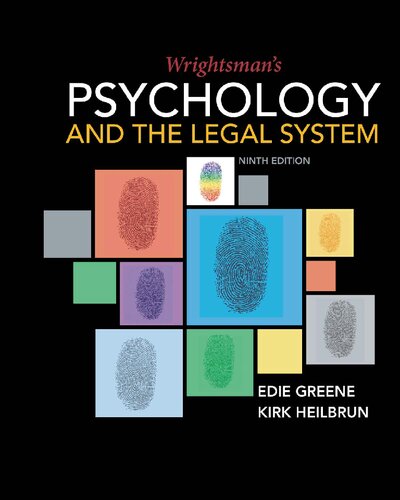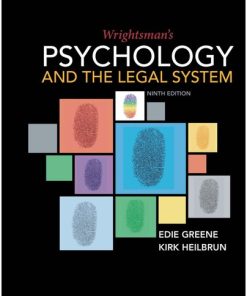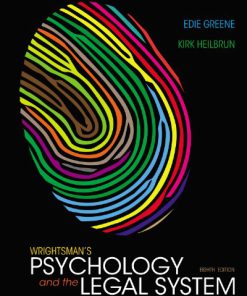Psychology and the Legal System 9th Edition by Edith Greene, Kirk Heilbrun 9798214356426
$50.00 Original price was: $50.00.$25.00Current price is: $25.00.
Psychology and the Legal System 9th Edition by Edith Greene, Kirk Heilbrun – Ebook PDF Instant Download/DeliveryISBN: 9798214356426
Full download Psychology and the Legal System 9th Edition after payment.

Product details:
ISBN-13 : 9798214356426
Author : Edith Greene, Kirk Heilbrun
Does trauma spark brazen acts? Are eyewitnesses accurate reporters? Can jurors distinguish truth from lies? Answer these and more in WRIGHTMAN’S PSYCHOLOGY AND THE LEGAL SYSTEM, 9th Edition. Real cases such as Bill Cosby and Dylann Roof illustrate the flesh and blood of the psychological issues considered in the book–from the motivations of offenders to discretion in sentencing. This book gives you an eye-opening overview of psychology’s contributions to the legal system–and the many roles available to trained psychologists within the system.
Psychology and the Legal System 9th Table of contents:
Chapter 1. Psychology and the Law: Choices and Roles
The Importance of Laws
Laws as Human Creations
Laws Help Resolve Conflict and Protect the Public
The Changing of Laws
The Psychological Study of Law
Basic Choices in the Psychological Study of the Law
The First Choice: Rights of Individuals versus the Common Good
The Second Choice: Equality versus Discretion
The Third Choice: To Discover the Truth or to Resolve Conflicts
The Fourth Choice: Science versus the Law as a Source of Decisions
Psychologists’ Roles in the Law
The Psychologist as a Basic Scientist of the Law
The Psychologist as an Applied Scientist in the Law
The Psychologist as a Policy Evaluator in the Law
The Psychologist as a Forensic Evaluator in Litigation
The Psychologist as a Consultant in Litigation
Summary
Key Terms
Chapter 2. The Legal System: Issues, Structure, and Players
The Adversarial System
Legality versus Morality
Citizens’ Sense of Legality and Morality
What Is Justice?
Distributive and Procedural Justice
Commonsense Justice: Everyday Intuitions about Fairness
Courts
State Courts
Federal Courts
The U.S. Supreme Court
Players in the Legal System: Judges
How Are Judges Selected?
Influences on Judicial Judgments
How Do Judges Decide?
Players in the Legal System: Lawyers
Lawyers’ Work Settings
Law Schools and Legal Education
Professional Satisfaction among Lawyers
How Do Lawyers Make Professional Decisions?
Summary
Key Terms
Chapter 3. Psychology of Crime
Offending in the United States
Serious Offending
School Violence
Mass Killings in Public Places
Why Does Crime Happen?
Theories of Crime as Explanations of Criminal Behavior
Sociological Theories of Crime
Biological Theories of Crime
Psychological Theories of Crime
Social–Psychological Theories of Crime
Integration of Theories of Crime
Summary
Key Terms
Chapter 4. Psychology of Police
Selection of Police Officers
The Interview
Situational Tests
Psychological Tests
The Validity of Police Screening
Fitness-for-Duty Evaluations
Training of Police Officers
Training in Crisis Intervention
Interactions with Mentally Ill Citizens
Domestic Disturbances
Hostage Negotiation and Terrorism
The Police Officer’s Job
Stress and the Police
Police–Community Relations
The Future of Policing in the United States in the 21st Century: The President’s Task Force Report
Building Trust and Legitimacy
Policy and Oversight
Technology and Social Media
Community Policing and Crime Reduction
Training and Education
Officer Wellness and Safety
Summary
Key Terms
Chapter 5. Eyewitnesses to Crimes and Accidents
Examples of Mistaken Eyewitness Identification
How Mistaken Eyewitness Identifications Occur
Basic Information Processing
Perception
Memory
How Psychologists Study Eyewitness Identification
The Variables That Affect Eyewitness Accuracy
Assessing the Impact of Estimator Variables
Controlling the Impact of System Variables
Reforming Identification Procedures
Interviewing Eyewitnesses
Lineup Instructions
Lineup Presentation Method
The Influence of Feedback
Eyewitness Confidence
The Eyewitness in the Courtroom
Safeguards against Mistaken Identification
Limiting Eyewitness Testimony
Expert Testimony
Jury Instructions
Children as Witnesses
Children as Eyewitnesses to Crimes
Children as Victims of Maltreatment
Investigative Interviews
Disclosure of Child Maltreatment
The Child Witness in the Courtroom
Procedural Modifications When Children Are Witnesses
Repressed and Recovered Memories
Repressed Memories of Child Sexual Abuse
Recovered Memories in Court
Creating False Memories
Summary
Key Terms
Chapter 6. Psychology of Victims of Crime and Violence
Perception of Those Who Experience Crime and/or Violence
Types of Victims
Adversity and Trauma in Childhood
Consequences of Early Victimization
Violence, Crime, and Posttraumatic Stress Disorder
Posttraumatic Stress Disorder
Battered Spouses
Prevalence Rates
Beliefs about Domestic Violence
The Causes of Battering
The Cycle of Violence
Responses to Victims of Battering
The Psychology of Rape
Misleading Stereotypes about Rape
Facts about Rape
Motivations and Characteristics of Rapists
Acquaintance Rape and “Date Rape”
Consequences of Being Raped
How Do Victims React to Being Raped?
Preventing Rape
Sexual Harassment
Defining Sexual Harassment
Prevalence Rates
Applying Psychological Knowledge to Detecting Harassment
Offenders’ Experience as Victims of Crime, Violence, and Trauma
Summary
Key Terms
Chapter 7. Evaluating Criminal Suspects
Profiling of Criminal Suspects
Classifying Homicide Offenders: Mass and Serial Murderers
Steps Involved in Criminal Profiling
The Validity of Criminal Profiles
Becoming an FBI Profiler
Detecting Deception
Methods of Detecting Deception
Evaluating Confessions
Historical Background and Current Legal Standing
Whittling Away at Miranda
The Validity of Confession Evidence
Inside the Interrogation Room: Common Interrogation Techniques
False Confessions
Inside the Courtroom: How Confession Evidence Is Evaluated
Reforming the System to Prevent False Confessions
Summary
Key Terms
Chapter 8. Traditional Prosecutions: Arrest, Bail, Plea Bargain and Settlement, and Trial
Steps Between Arrest and Trial
The Initial Appearance
The Preliminary Hearing
The Grand Jury
Arraignment
Discovery and Pretrial Motions
The Decision to Set Bail
What Considerations Affect the Decision to Set Bail?
Does Pretrial Release Affect Trial Outcome?
Can High-Risk Defendants Be Identified?
Plea Bargaining in Criminal Cases
Benefits of Plea Bargaining for Defendants and Attorneys
Psychological Influences on the Plea-Bargaining Process
Evaluations of Plea Bargaining
Settlements in Civil Cases
Factors That Determine Settlement Amounts
What Is the Purpose of a Trial?
The Trial as a Search for the Truth
The Trial as a Test of Credibility
The Trial as a Conflict-Resolving Ritual
Steps in the Trial Process
Preliminary Actions
The Trial
Sentencing
The Appellate Process
Courtroom of the Future
Summary
Key Terms
Chapter 9. Alternatives to Traditional Prosecution
Alternative Dispute Resolution
Arbitration
Summary Jury Trial
Mediation
Beliefs about Alternative Dispute Resolution
Community Alternatives to Standard Prosecution
Community-Based Alternatives and the Sequential Intercept Model
Problem-Solving Courts
The Future of Community-Based Alternatives to Prosecution
Summary
Key Terms
Chapter 10. Forensic Assessment in Juvenile and Criminal Cases
The Scope of Forensic Psychology
Competence
Adjudicative Competence
Raising the Issue of Competence
Evaluating Competence
Results of Competence Evaluations
Competent with Medication, Incompetent Without
Other Legal Competencies
Juvenile Competence to Stand Trial
The Insanity Defense
Rationale for the Insanity Defense
Varying Insanity Defense Rules
Famous Trials and the Use of the Insanity Plea
Facts about the Insanity Defense
Public Perceptions of the Insanity Defense
Current Criticisms of the Insanity Defense
Revisions and Reforms of the Insanity Defense
Capital Sentencing Evaluations
Juvenile Transfer
Summary
Key Terms
Chapter 11. Forensic Assessment in Civil Cases
Experts in the Adversarial System
Psychological Damages to Civil Plaintiffs
Assessment of Psychological Damages
Workers’ Compensation
Assessment in Workers’ Compensation Claims
Civil Competencies
Assessing Competence to Make Treatment Decisions
Assessing Competence to Execute a Will
Psychological Autopsies
Child Custody and Parental Fitness
The “Best Interests of the Child” in Custody Disputes
Assessment in Custody Disputes
Assessing Fitness to Be a Parent
Civil Commitment and Risk Assessment
Four Types of Commitment Procedures
Dangerousness and Risk Assessment
Difficulties in Assessing Dangerousness
Summary
Key Terms
Chapter 12. Preparing for Trials
Who Should Decide: Jury or Judge?
How Judges and Juries Compare
Determinants of Discrepancies
Newer Data on Judge/Jury Differences
Jury Selection Begins in the Community: Forming a Panel, or Venire
Judicial and Legislative Reforms
Jury Selection Continues in the Courtroom: The Voir Dire Process
Challenges for Cause and Peremptory Challenges
Pre-Trial Publicity
Conflicting Rights
Effects of Pre-Trial Publicity
Remedies for the Effects of Pre-Trial Publicity
Summary
Key Terms
Chapter 13. Jurors and Juries
How Jurors Think
The Story Model
Are Jurors Competent?
Jurors Rely on Relevant Evidence, Seen through the Lens of Their Emotions
Jurors’ Understanding of Expert Testimony
Jurors’ Abilities to Understand Their Instructions
Jurors’ Willingness to Apply Their Instructions
Jurors’ Abilities to Decide Complex Cases
Effects of Extralegal Information
Can Jurors Disregard Inadmissible Evidence?
Are Jurors Biased?
The Assumption of a Blank Slate
Inevitability of Juror Bias
How Juries Deliberate
Jury Reform
The Jury: Should It Be Venerated or Vilified? Revered or Reviled?
Summary
Key Terms
Chapter 14. Punishment and Sentencing
The Purposes of Punishment
Utilitarian Approaches
Retributive Approaches
Restorative Approaches
Judicial Discretion in Sentencing
Sentencing Policies
Sentencing Process
Determinants of Sentencing: Relevant and Irrelevant
Sentencing Juvenile Offenders
Juvenile Court Dispositions
Blended Sentencing
Life Sentences for Juvenile Offenders
Sentencing Sex Offenders
Registration and Notification
Residency Restrictions
Involuntary Commitment
Mandated Treatments for Sex Offenders
The Death Penalty: The Ultimate Punishment
Concerns about Innocence
Justifications for the Death Penalty
Equality versus Discretion in Application of the Death Penalty
Capital Jury Decision-Making
Limiting Use of the Death Penalty
Summary
Key Terms
Chapter 15. Juvenile and Adult Corrections
Juvenile Corrections
Assessing Risk and Needs in Juveniles
Community-Based Interventions
Secure Residential Interventions
Reentry
Adult Corrections
Assessing and Diverting Offenders
Community-Based Interventions
Institutional Interventions
Psychological Consequences of Imprisonment
People also search for Psychology and the Legal System 9th:
wrightsman’s psychology and the legal system 10th edition
wrightsman’s psychology and the legal system 9th edition
wrightsman’s psychology and the legal system 10th edition pdf
wrightsman’s psychology and the legal system 9th edition pdf free
wrightsman’s psychology and the legal system pdf
Tags: Psychology, Legal System, Edith Greene, Kirk Heilbrun, eyewitnesses
You may also like…
Uncategorized
Uncategorized
Psychology - Pedagogy
Jurisprudence & Law - Foreign & International Law
Business & Economics
Arts - History & Criticism












